Graphic Scores-avant-garde: Difference between revisions
Andre Castro (talk | contribs) |
Andre Castro (talk | contribs) No edit summary |
||
| (17 intermediate revisions by the same user not shown) | |||
| Line 1: | Line 1: | ||
Pad: https://pad.pzimediadesign.nl/p/pts-2017-01-26 | |||
=Graphic scores in 20th century avant-garde= | =Graphic scores in 20th century avant-garde= | ||
http://www.juilliard.edu/sites/juilliard.edu/files/journal/2012/05/cage-john.jpg | |||
John Cage will be the center figure of this session. Not only due to its the 20th century Western avant-garde music, but moreover, due to the extensive of his exploration of graphical scores, which range from more conventional open scores to systems for generating scores. | John Cage will be the center figure of this session. Not only due to its the 20th century Western avant-garde music, but moreover, due to the extensive of his exploration of graphical scores, which range from more conventional open scores to systems for generating scores. | ||
== why graphic scores == | == why graphic scores? == | ||
Keeping the focus on music or sound art, it should be asked '''why are graphic scores needed?''' Why were they employed in musical composition? | Keeping the focus on music or sound art, it should be asked '''why are graphic scores needed?''' Why were they employed in musical composition? | ||
| Line 9: | Line 14: | ||
'''What are the approaches and ideas that graphic scores is better suited to express, than conventional westerner notation?''' | '''What are the approaches and ideas that graphic scores is better suited to express, than conventional westerner notation?''' | ||
* | ==John Cage ''Sonatas and Interludes for Prepared Piano'' (1946–48)== | ||
** | http://exhibitions.nypl.org/johncage/sites/exhibitions.nypl.org.johncage/files/Prepared-Piano.jpg | ||
** David Tudor ''Rainforest'' - | |||
http://exhibitions.nypl.org/johncage/sites/exhibitions.nypl.org.johncage/files/Directions-Prepared-Piano.jpg | |||
* the prepared piano entered Cage's repertoire with the composition ''Bacchanale''(1940) for a dance piece by Syvilla Fort | |||
* Cage wanted to compose a piece with a large amount percussion sounds, however he lacked the space on space for this, and was only provided with a piano | |||
* he started experimenting with placing metal, rubber and wood objects on the piano strings, to obtain percussion like sounds | |||
* his preparation provided to a pianist a pallet of sounds and an interface that could only be achieved by a large number of percussionists | |||
* although the score for ''Sonatas and Interludes for Prepared Piano'' is not a graphic score, it included graphic and text notes on how to prepare the piano | |||
http://dreixel.net/hauptwerk/image/cage2.png | |||
http://dreixel.net/hauptwerk/image/cage1.png | |||
http://dreixel.net/hauptwerk/image/cage3.png | |||
https://www.youtube.com/watch?v=3w7GeJCLpJc | |||
==John Cage ''Music of Changes'' (1951)== | |||
https://upload.wikimedia.org/wikipedia/en/1/1e/Music-of-changes-4-1.gif | |||
* composed for David Tudor | |||
* in its compositional process Cage use the divination text ''I Ching: The book of Change'' as a chance mechanism | |||
** by tossing coins one arrives at an hexagram and a corresponding ambiguous text | |||
* change determined the sonority (not only pitches, but also complex sounds), durations and dynamics of the different sound events of the piece | |||
https://upload.wikimedia.org/wikipedia/commons/6/6b/Iching-hexagram-08.svg Hexagram 8 ''Holding together'' | |||
* https://www.youtube.com/watch?v=eAjKD12RkEY | |||
* http://www.ichingonline.net | |||
* [https://en.wikipedia.org/wiki/I_Ching ''I Ching''] | |||
* [https://en.wikipedia.org/wiki/List_of_hexagrams_of_the_I_Ching List of ''I Ching'' hexagrams] | |||
==Jonh Cage ''Imaginary Landscape N°4'' (1951)== | |||
* An electronic composition for 12 radios, operated by two performers each | |||
* the ''I Ching'' was used to create the score: notating volume and tune control | |||
* More than created by chance this work was ''indeterminate'', as the source of sound - the radio spectrum - it is not known | |||
https://chrissypianist.files.wordpress.com/2012/08/imaginary-landscape-2-pg-1.jpg | |||
* https://www.youtube.com/watch?v=yV-kWU1Z5u8 | |||
* https://www.youtube.com/watch?v=iRa0j_EIth0 | |||
==David Tudor ''Rainforest'' (I - 1968)(IV - 1973)== | |||
http://davidtudor.org/Graphics/rfDiagram73.jpg | |||
* "sound transformations without the use of electronic modulation: the source sounds, when transmitted through the physical materials, will be modified by the resonant nodes of those materials" | |||
* "The contact mikes on the objects pickup the resonant frequencies which one hears when very close to the object, and then are amplified through a loudspeaker as an enhancement" | |||
* "a large group piece actually, any number of people can participate in it… [E]ach person makes their own sculpture, decides how to program it, and performs it themselves" | |||
* score: diagram describing the connection of the piece's constituent elements | |||
* a piece that can compose itself out of its constituent elements | |||
* indeterminacy | |||
http://4.bp.blogspot.com/-nqUObFXUkjA/TnYhTjAp2fI/AAAAAAAAA4I/GD93eTTBup0/s1600/moogpatch2.jpg | |||
http://1.bp.blogspot.com/__w9YdjE55dY/SLv4ixsoBCI/AAAAAAAAAIY/GPS8zTXKEyY/s1600-h/MOTM_Flute_Patchsheet.jpg | |||
https://3.bp.blogspot.com/-HVetoUaHXu0/VsVALYBLSOI/AAAAAAAAIt4/TZ7kBzTmSb4/s1600/20160218_141517.jpg | |||
* http://davidtudor.org/Works/rainforest.html | |||
* http://composers-inside-electronics.net/rainforest/rainforest/RAINFOREST.html | |||
* https://www.youtube.com/embed/iT9HP48sHTg | |||
* http://www.getty.edu/research/tools/guides_bibliographies/david_tudor/av/rainforest.html | |||
* Holzer, Derek, and Mads BEch Paulszewski. n.d. “Rainforest 2012.” http://macumbista.net/files/rainforest_overview.pdf | |||
* Driscoll, John, and Matt Rogalsky. 2004. “David Tudor’s ‘Rainforest’: An Evolving Exploration of Resonance.” Leonardo Music Journal 14: 25–30. http://www.jstor.org/stable/1513502 | |||
* “Vague Terrain 19: Schematic as Score | Vague Terrain.” 2017. Accessed January 24. http://web.archive.org/web/20150227025105/http://vagueterrain.net/journal19. | |||
==John Cage ''Fontana Mix'' (1958)== | |||
http://www.bbc.co.uk/staticarchive/5b15f7b4e45ec255d9017f253c4faed1ae95a2f2.jpg | |||
* Initially created for composing tape music | |||
* Luciano Berio's invited Cage to compose a tape piece at the studio of the Milan radio | |||
* The piece/score boroughs its name from Cage's Milanese landlady, Signora Fontana | |||
* Although initially the score was created for composing tape music pieces, Cage understood it could serve other compositional contexts. | |||
* More than a score, perhaps a meta-score, or a tool that allowed many scores to be created from it. | |||
** ''Aria'' - for single voice | |||
** ''Sounds of Venice'' (1959) - performance | |||
** ''Water Walk'' (1959) - performance. [[#score of Water Walk|Score]] https://www.youtube.com/watch?v=gXOIkT1-QWY https://www.youtube.com/watch?v=gXOIkT1-QWY | |||
** ''Theatre Piece'' (1960) - for 1 to 8 performers of any sort (musicians, dancers, singers) | |||
Elements of the score: | |||
* 1 straight line | |||
* 1 graph/grid | |||
* 10 sheets with dots | |||
* 10 sheets with 6 different curved lines: solid or dotted, in 3 different thicknesses | |||
=== Water Walk score === | |||
http://exhibitions.nypl.org/johncage/sites/exhibitions.nypl.org.johncage/files/1709953u.jpg | |||
http://exhibitions.nypl.org/johncage/sites/exhibitions.nypl.org.johncage/files/1709954u.jpg | |||
http://exhibitions.nypl.org/johncage/sites/exhibitions.nypl.org.johncage/files/1709955u.jpg | |||
http://exhibitions.nypl.org/johncage/sites/exhibitions.nypl.org.johncage/files/1709956u.jpg | |||
http://exhibitions.nypl.org/johncage/sites/exhibitions.nypl.org.johncage/files/1709957u.jpg | |||
Floor plan of Water Walk | |||
http://johncage.tonspur.at/wp-content/uploads/2011/12/water-walk-2-e1325859034146.jpeg | |||
= Bibliography = | |||
Austin, Larry, and Douglas Kahn. 2017. “Source: Music of the Avant Garde: Everything Changes.” Accessed January 24. http://aaaaarg.fail/thing/52b2f8fb307888821400000c. | |||
Barry, Robert. 2017. “Graphic Scores: From the Symbolic to the Indexical - The Wire.” The Wire Magazine - Adventures In Modern Music. Accessed January 24. http://www.thewire.co.uk/in-writing/columns/robert-barry_drawing-towards-sound. | |||
Driscoll, John, and Matt Rogalsky. 2004. “David Tudor’s ‘Rainforest’: An Evolving Exploration of Resonance.” Leonardo Music Journal 14: 25–30 http://www.jstor.org/stable/1513502. | |||
Eco, Umberto. 1989. “Poetics of the Open.” In The Open Work, 1–23. Cambridge, Massachusetts+: Harvard Univerity Press. https://monoskop.org/images/6/6b/Eco_Umberto_The_Open_Work.pdf. | |||
The | |||
Holzer, Derek, and Mads BEch Paulszewski. n.d. “Rainforest 2012.” http://macumbista.net/files/rainforest_overview.pdf. | |||
Lucier, Alvin. 2012. Music 109: Notes on Experimental Music. Wesleyan University Press. https://monoskop.org/log/?p=12720. | |||
Pritchett, James. 1993. The Music of John Cage. Cambridge University Press. https://books.google.nl/books?id=riHo22Hi8QAC&printsec=frontcover&redir_esc=y&hl=en#v=onepage&q&f=false. | |||
“Realizing Cage’s Cartridge Music | Jaime E Oliver | Computer Music.” 2017. Accessed January 23. http://www.jaimeoliver.pe/recipes/archaeology/cartridge. | |||
“‘Source: Music of the Avant Garde: Everything Changes.’” 2017. Laboratorie New Music. Accessed January 24. http://www.laboratorienewmusic.com/source-music-of-the-avant-garde-everything-changes/. | |||
“Vague Terrain 19: Schematic as Score | Vague Terrain.” 2017. Accessed January 24. http://web.archive.org/web/20150227025105/http://vagueterrain.net/journal19. | |||
Latest revision as of 15:19, 26 January 2017
Pad: https://pad.pzimediadesign.nl/p/pts-2017-01-26
Graphic scores in 20th century avant-garde

John Cage will be the center figure of this session. Not only due to its the 20th century Western avant-garde music, but moreover, due to the extensive of his exploration of graphical scores, which range from more conventional open scores to systems for generating scores.
why graphic scores?
Keeping the focus on music or sound art, it should be asked why are graphic scores needed? Why were they employed in musical composition?
The immediate answer might simply be to express compositional approaches or ideas in a score that conventional westerner notation is not able to do.
What are the approaches and ideas that graphic scores is better suited to express, than conventional westerner notation?
John Cage Sonatas and Interludes for Prepared Piano (1946–48)


- the prepared piano entered Cage's repertoire with the composition Bacchanale(1940) for a dance piece by Syvilla Fort
- Cage wanted to compose a piece with a large amount percussion sounds, however he lacked the space on space for this, and was only provided with a piano
- he started experimenting with placing metal, rubber and wood objects on the piano strings, to obtain percussion like sounds
- his preparation provided to a pianist a pallet of sounds and an interface that could only be achieved by a large number of percussionists
- although the score for Sonatas and Interludes for Prepared Piano is not a graphic score, it included graphic and text notes on how to prepare the piano
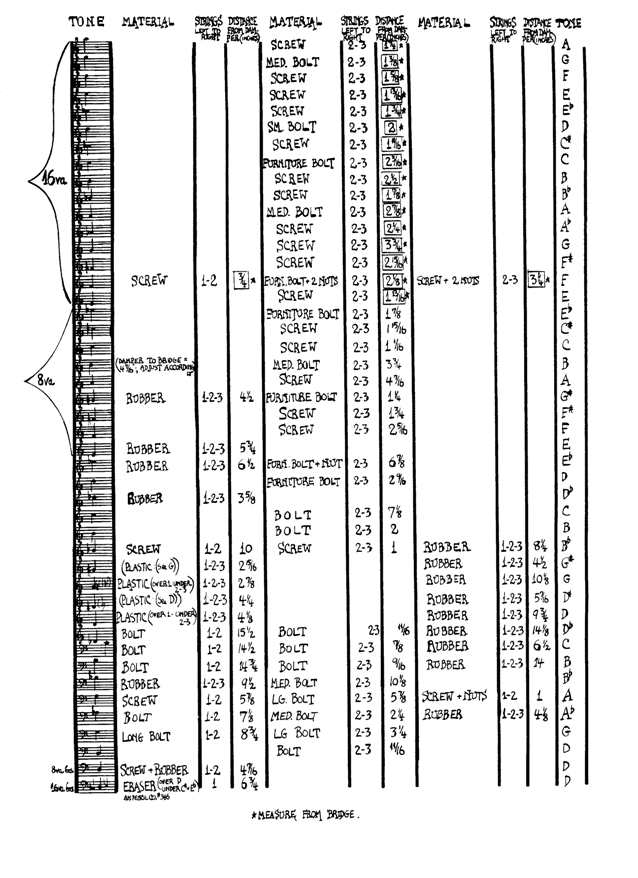
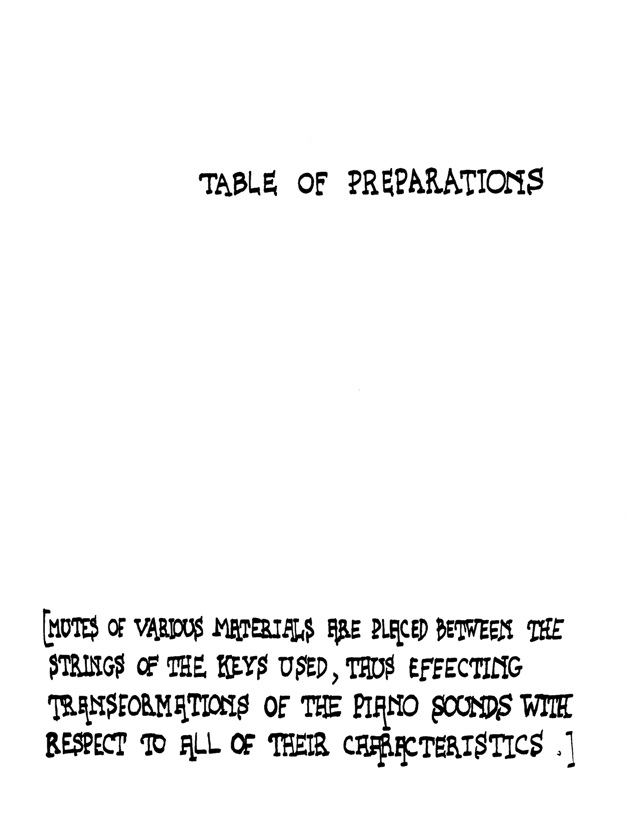
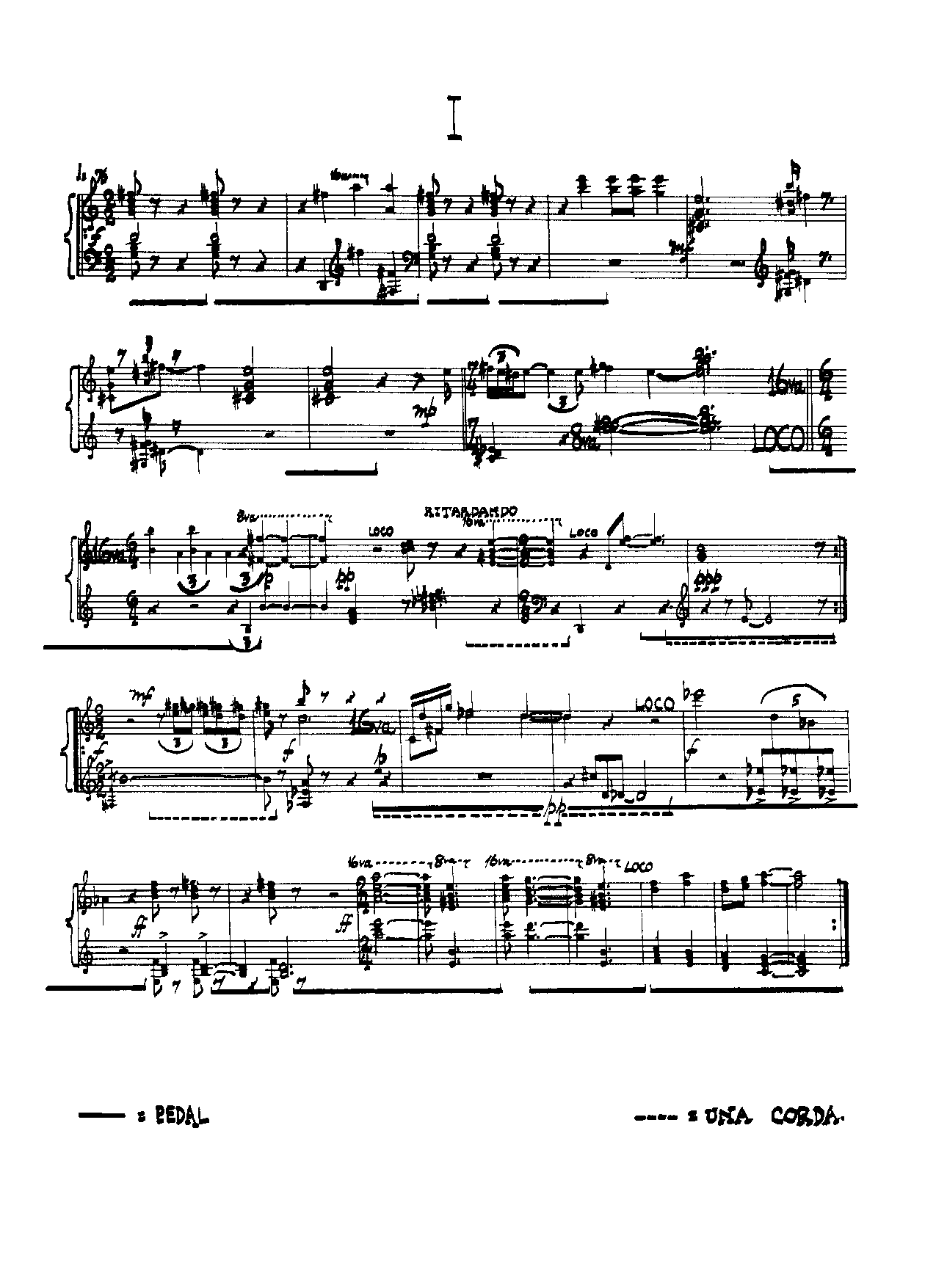
https://www.youtube.com/watch?v=3w7GeJCLpJc
John Cage Music of Changes (1951)

- composed for David Tudor
- in its compositional process Cage use the divination text I Ching: The book of Change as a chance mechanism
- by tossing coins one arrives at an hexagram and a corresponding ambiguous text
- change determined the sonority (not only pitches, but also complex sounds), durations and dynamics of the different sound events of the piece
https://upload.wikimedia.org/wikipedia/commons/6/6b/Iching-hexagram-08.svg Hexagram 8 Holding together
- https://www.youtube.com/watch?v=eAjKD12RkEY
- http://www.ichingonline.net
- I Ching
- List of I Ching hexagrams
Jonh Cage Imaginary Landscape N°4 (1951)
- An electronic composition for 12 radios, operated by two performers each
- the I Ching was used to create the score: notating volume and tune control
- More than created by chance this work was indeterminate, as the source of sound - the radio spectrum - it is not known
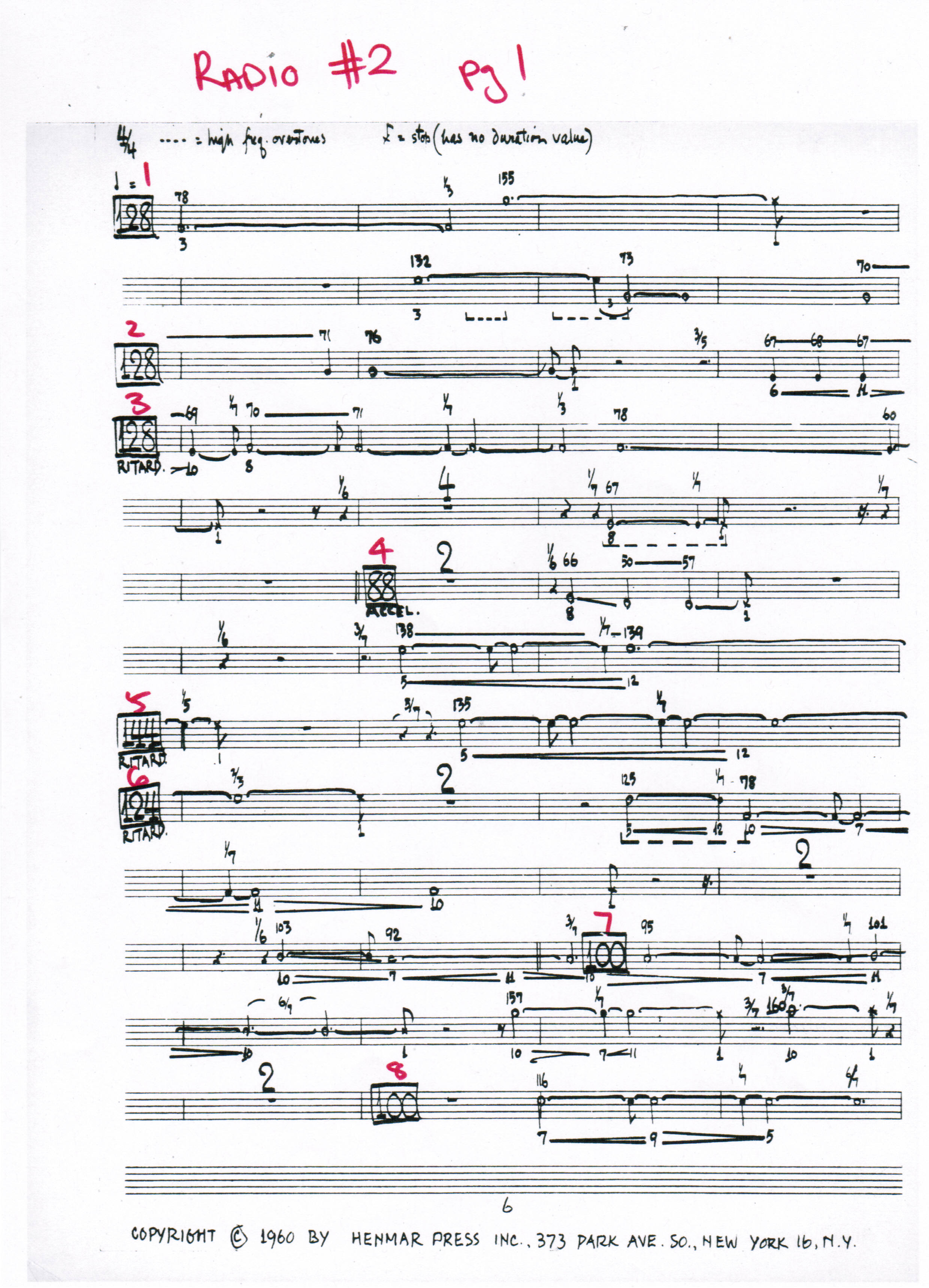
David Tudor Rainforest (I - 1968)(IV - 1973)

- "sound transformations without the use of electronic modulation: the source sounds, when transmitted through the physical materials, will be modified by the resonant nodes of those materials"
- "The contact mikes on the objects pickup the resonant frequencies which one hears when very close to the object, and then are amplified through a loudspeaker as an enhancement"
- "a large group piece actually, any number of people can participate in it… [E]ach person makes their own sculpture, decides how to program it, and performs it themselves"
- score: diagram describing the connection of the piece's constituent elements
- a piece that can compose itself out of its constituent elements
- indeterminacy


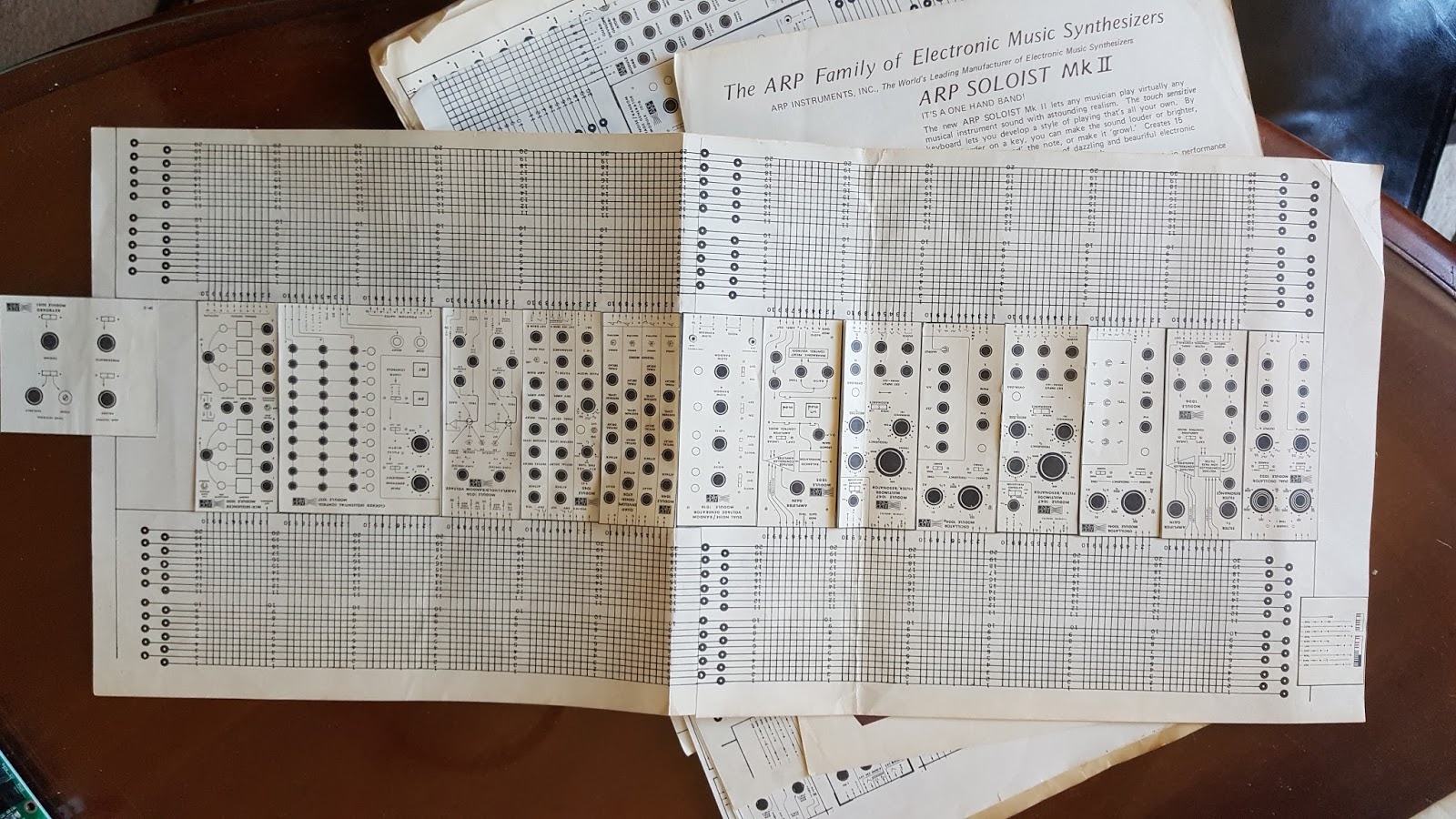
- http://davidtudor.org/Works/rainforest.html
- http://composers-inside-electronics.net/rainforest/rainforest/RAINFOREST.html
- https://www.youtube.com/embed/iT9HP48sHTg
- http://www.getty.edu/research/tools/guides_bibliographies/david_tudor/av/rainforest.html
- Holzer, Derek, and Mads BEch Paulszewski. n.d. “Rainforest 2012.” http://macumbista.net/files/rainforest_overview.pdf
- Driscoll, John, and Matt Rogalsky. 2004. “David Tudor’s ‘Rainforest’: An Evolving Exploration of Resonance.” Leonardo Music Journal 14: 25–30. http://www.jstor.org/stable/1513502
- “Vague Terrain 19: Schematic as Score | Vague Terrain.” 2017. Accessed January 24. http://web.archive.org/web/20150227025105/http://vagueterrain.net/journal19.
John Cage Fontana Mix (1958)

- Initially created for composing tape music
- Luciano Berio's invited Cage to compose a tape piece at the studio of the Milan radio
- The piece/score boroughs its name from Cage's Milanese landlady, Signora Fontana
- Although initially the score was created for composing tape music pieces, Cage understood it could serve other compositional contexts.
- More than a score, perhaps a meta-score, or a tool that allowed many scores to be created from it.
- Aria - for single voice
- Sounds of Venice (1959) - performance
- Water Walk (1959) - performance. Score https://www.youtube.com/watch?v=gXOIkT1-QWY https://www.youtube.com/watch?v=gXOIkT1-QWY
- Theatre Piece (1960) - for 1 to 8 performers of any sort (musicians, dancers, singers)
Elements of the score:
- 1 straight line
- 1 graph/grid
- 10 sheets with dots
- 10 sheets with 6 different curved lines: solid or dotted, in 3 different thicknesses
Water Walk score





Floor plan of Water Walk

Bibliography
Austin, Larry, and Douglas Kahn. 2017. “Source: Music of the Avant Garde: Everything Changes.” Accessed January 24. http://aaaaarg.fail/thing/52b2f8fb307888821400000c.
Barry, Robert. 2017. “Graphic Scores: From the Symbolic to the Indexical - The Wire.” The Wire Magazine - Adventures In Modern Music. Accessed January 24. http://www.thewire.co.uk/in-writing/columns/robert-barry_drawing-towards-sound.
Driscoll, John, and Matt Rogalsky. 2004. “David Tudor’s ‘Rainforest’: An Evolving Exploration of Resonance.” Leonardo Music Journal 14: 25–30 http://www.jstor.org/stable/1513502.
Eco, Umberto. 1989. “Poetics of the Open.” In The Open Work, 1–23. Cambridge, Massachusetts+: Harvard Univerity Press. https://monoskop.org/images/6/6b/Eco_Umberto_The_Open_Work.pdf.
Holzer, Derek, and Mads BEch Paulszewski. n.d. “Rainforest 2012.” http://macumbista.net/files/rainforest_overview.pdf.
Lucier, Alvin. 2012. Music 109: Notes on Experimental Music. Wesleyan University Press. https://monoskop.org/log/?p=12720.
Pritchett, James. 1993. The Music of John Cage. Cambridge University Press. https://books.google.nl/books?id=riHo22Hi8QAC&printsec=frontcover&redir_esc=y&hl=en#v=onepage&q&f=false.
“Realizing Cage’s Cartridge Music | Jaime E Oliver | Computer Music.” 2017. Accessed January 23. http://www.jaimeoliver.pe/recipes/archaeology/cartridge.
“‘Source: Music of the Avant Garde: Everything Changes.’” 2017. Laboratorie New Music. Accessed January 24. http://www.laboratorienewmusic.com/source-music-of-the-avant-garde-everything-changes/.
“Vague Terrain 19: Schematic as Score | Vague Terrain.” 2017. Accessed January 24. http://web.archive.org/web/20150227025105/http://vagueterrain.net/journal19.
